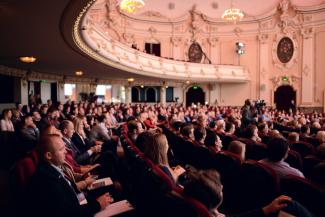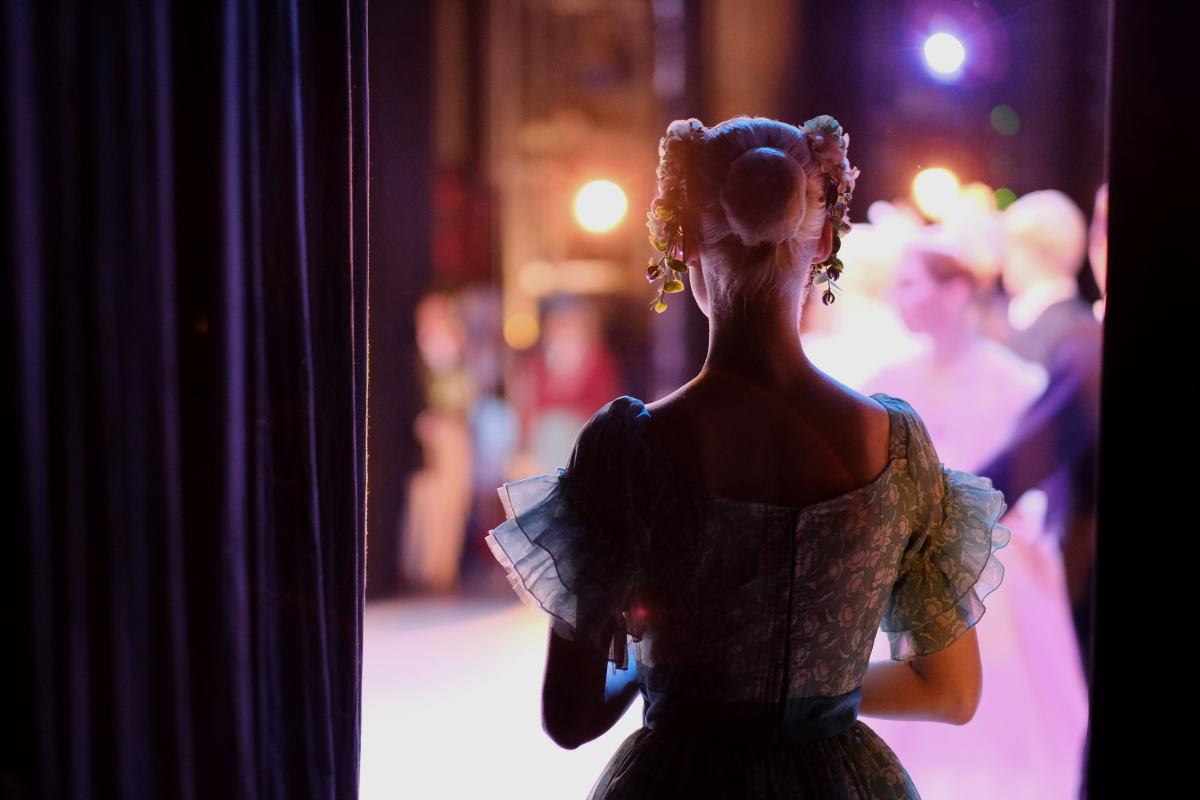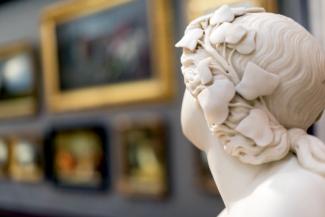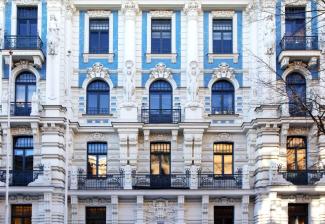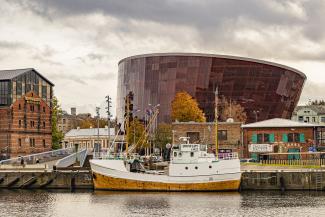Every country has its own history, traditions, cultural heritage, achievements, challenges and innovations. However, it is important to be able to enjoy this plethora of cultural and historical factors right here and now. In the capital of Latvia, Riga, there are ample opportunities to feel the local culture and art in a variety of manifestations, which makes visiting a more interesting, more profound and more diverse experience.
Currently, the most recognisable and world-famous Latvian cultural export is certainly the animated film “Flow”, made in Latvia in 2024, directed by Riga native Gints Zilbalodis. “Flow” is the first film made in Latvia to win many important awards, including the 82nd Golden Globe Award and the 97th Academy Award in the category “Best Animated Film”.
Riga has been the epicentre of Latvian culture, art, and technology at various times, and therefore continues to be of interest to curious and creative travellers today. In this article, we will give a brief insight into the cultural segments to explore and enjoy in the Latvian capital, Riga.
Latvian cultural history
Latvian culture is a set of tangible and intangible cultural expressions created by the Latvian people. Latvians have preserved a rich heritage of folk music and dance. The Song and Dance Festival is popular, taking place once every 5 years and bringing together thousands of participants from all over Latvia. The Song Festival is included in the UNESCO List of Intangible Cultural Heritage of Humanity. Traditional folk costumes vary in different regions of Latvia and are often used during celebrations and cultural events. One of the most important holidays in Latvian culture is the summer solstice, which is celebrated with songs, dances, bonfires and various rituals. Christian holidays such as Christmas and Easter are also deeply integrated into Latvian culture, often mixing with ancient traditions. Riga is famous for its Art Nouveau architecture, which makes up a large part of the city centre. Latvia has a strong theatre tradition. The beginning of Latvian cinema is considered to be 1910, when the first documentary short film was shot. Feature films began to be shot in 1913. In parallel with the development of culture, people's habits were significantly changed by technical and scientific innovations, or industrial heritage, which over time also significantly influenced the daily life and habits of Latvian residents. The first companies manufacturing wagons, bicycles (1886), cars (1909) and aircraft (1910) in the region were established in Riga. Riga became an important mechanical engineering centre, also in the production of electrical equipment. Riga was the centre of technological development in Eastern Europe, similar to the modern “Silicon Valley”.
MUSEUM EXPERIENCE
History museums
National History Museum of Latvia collects, preserves, researches, interprets and represents various themes of Latvian history in a modern way, as well as creates an exciting and content-rich experience for museum visitors. National History Museum of Latvia operates in four locations in Riga: the museum's exhibitions are located in the Riga Castle, Dauderis and the Popular Front Museum, while the administration, museum specialists, researchers, restorers and the collection are located in the Museum Storage on Pulka Street.
The exhibitions of the Latvian War Museum reflect the military and political history of Latvia, with a special emphasis on the 20th century, when the Latvian people had to fight for their independence twice. These battles for freedom demonstrated the heroism and courage of Latvian soldiers, as well as their ability to defend their homeland against foreign powers. The museum has exhibitions dedicated to the military history of the Middle Ages and modern times, as well as the First and Second World Wars, the proclamation of an independent Latvian state, liberation struggles, and the establishment of the state.
Museum of the History of Riga and Navigation introduces the emergence and development of Riga over more than 800 years, as well as shipping in the territory of Latvia from the 10th century to the present day. The expositions feature unique historical evidence: ancient Latvian jewellery, tools and weapons, the 13th century “Riga Ship”, weights and measures from the times of the Hanseatic League, the sword of the Riga executioner, the world’s smallest camera MINOX, outstanding creations of Riga silversmiths, one of Riga’s ancient wonders – Great Kristaps, as well as other exhibits.
Mentzendorff’s House with the atmosphere of a 17th–18th century dwelling is the only museum of its kind in the Baltics. The museum introduces the cultural traditions of a wealthy Riga resident. The exhibition features unique 17th–18th century ceiling and wall paintings. They are paired with historical interior items, creating a unique character and atmosphere of the space.
The Riga Art Nouveau Centre fully reveals the essence of Art Nouveau – from the layout of the rooms, original wall and ceiling paintings, stained glass windows, tiles in the kitchen, oak wall panels to door and window handles. The museum’s interior displays furniture, dishes, artwork, clocks, clothing, embroidery and other valuable items from the early 20th century in Riga.
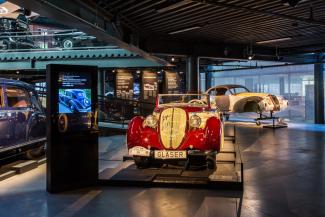
Art museums
Art lovers can visit two permanent exhibitions, which allow them to get acquainted with art created in Latvia in different periods, and also view various periodic, thematic exhibitions.
The Latvian National Museum of Art is the most important art museum in Latvia and the first building in the Baltics specifically built for the needs of an art museum. The Latvian National Museum of Art has a modern infrastructure and environment for exhibiting and preserving works of art, organising exhibitions, as well as educating the public and spending meaningful leisure time.
The Art Museum Riga Bourse houses the largest collection of foreign art in the Baltics, the creation of which was initiated in the 19th century by Riga's aldermen, merchants and burghers. Currently, the museum regularly hosts international exhibition projects and cultural and artistic events. The Art Museum Riga Bourse has five permanent exhibitions.
Several items from the collection of the Museum of Decorative Arts and Design have been included in the Latvian art and design canon and have received international recognition. Currently, the museum’s collection contains more than 11,928 items, and around 500 objects are on display in the exhibition halls. The permanent exhibition presents the works of leading Latvian designers and artists, as well as tells the story of the development of professional applied art and design from the end of the 19th century to the present day.
Romans Suta and Aleksandra Beļcova Museum. The museum is dedicated to two prominent figures in Latvian art history, representatives of classical modernism. The collection consists of approximately 4,000 works of art, including paintings, painted porcelain objects, ink drawings, watercolours, sketches of dishes, costumes and stage designs, as well as memorial furniture, household items and archival materials.
Museum Storage Facility and SCULPTURE FOREST is a 31 thousand square metre storage facility, which houses the collections of the National History Museum of Latvia, Latvian National Museum of Art, Museum of Literature and Music and Riga Film Museum. It is the largest collection of Latvian historical evidence, art, literature, music and cinema objects. In the museum storage facility, the National Museum of Art of Latvia offers two permanent exhibitions – “Sculpture Forest. Casts of Antique and Renaissance Sculpture” and the outdoor sculpture exhibition “Mythic Figures”.

Thematic museums
If you want to know why chocolate making has always been shrouded in mystery, you should visit the Laima Chocolate Museum. At the museum, you can enjoy chocolate with all your senses – sight, taste, sound, touch and smell. The museum invites you to taste a hot chocolate drink and find out how chocolate is made, see the ingredients of chocolate and learn the differences between types of chocolate, learn unheard facts and enjoy a journey into the world of chocolate, touch a wall of cocoa beans and find out how many years a cocoa tree grows.
Interactive space “Neredzamā pasaule”. A museum whose exposition is in complete darkness, it is impossible to see anything, but it is possible to use the other human senses and experience the contents of the museum in an unusual way. Museum guests, accompanied by a blind guide, get to know the objects in the dark and use various senses – sight, taste, sound, touch and smell.
The exhibition of the Latvian Sports Museum features various medals, cups, awards, sports memorabilia, documents, programmes, photographs, posters and banners, albums, sports equipment and clothing, sports paraphernalia, audio and video materials. During a visit to the museum, you can try your hand at sports: more active and physically stronger young people can climb a rock wall, while more erudite sports fans can test their knowledge in board games.
The Fashion Museum is the only specialised museum dedicated to fashion and fashion history in the Baltic States. The museum features a small but unique permanent exhibition, complemented by theatrical use of sound and light, as well as thematic exhibitions that change twice a year, offering both Riga residents and visitors the opportunity to learn about fashion and its design, as well as the history of clothing.
Since 2020, the first illusionist theatre and museum in Northeastern Europe, created by Dace and Enrico Pecolli, “Mystero”, has been operating in Riga. This unique project offers viewers the opportunity to experience exciting illusionist performances and discover the world of magic, which will delight both young and old visitors. The theatre will not only surprise with excellent performances, but will also become a place where art, magic and human imagination will unite.
Medical museums
The main exhibition of the Pauls Stradiņš Museum of the History of Medicine tells the story of the development of medicine. Visitors can see a medieval monastery hospital and pharmacy, visit a medieval town created according to the plans of Professor Pauls Stradiņš, as well as learn about the most common diseases of the time and their treatment methods.
If you want to get rid of a bad habit, namely smoking, then you should definitely visit the RSU Anatomy Museum of Riga Stradiņš University, because the lungs of a person who died from smoking are exhibited here. The museum’s collection consists of several thousand different and unusual objects – preparations of normal and pathological human anatomy, embryology, congenital anomalies, comparative anatomy preparations, as well as extensive anthropological material obtained during excavations and expeditions in the 1920s–1930s.
Technical museums
There are several technical museums in Riga that offer the opportunity to get acquainted with various technologies, engineering achievements and scientific discoveries.
The Riga Motor Museum houses the largest and most diverse collection of vintage vehicles in the Baltics. The museum’s exhibition is designed as an exciting and interactive story about events, people and vehicles, supplemented with multimedia and the latest technology solutions.
Latvian Railway History Museum. The railway connects people, promotes the economy and trade, and is an important element of the industrial revolution and modern society, becoming an important infrastructure. The Latvian Railway History Museum, established in 1990, invites you to explore this world. A special charm is added by the fact that the pulse of modern railways can be felt and heard here – a railway line passes nearby.
Latvian Fire Museum. Firefighters are known for their heroism, contribution to public safety and ability to work in difficult and dangerous conditions, often risking their lives to save others. They are huge machines, pumps and ladders and shiny helmets. At the Latvian Fire Museum, you can not only see all this, but even touch and try it out.
THEATRE, MUSIC, CINEMA
Theatre
If you want to understand Latvians, you should definitely visit a theatre that has shaped and reflected the collective consciousness and identity of Latvians over time. Theatre lovers in Riga can visit theatres of various types and with a diverse repertoire. For the convenience of foreign guests, some performances are offered with English subtitles.
The Latvian National Theatre is one of the leading professional repertory theatres in Latvia. It is a modern theatre, proud of its traditions and 100-year history. The theatre considers the popularisation of Latvian drama to be one of its main tasks, therefore every season it includes new productions of works by Latvian authors in its repertoire.
Dailes Theatre is the largest professional theatre in the Baltics with more than a century-old tradition. The theatre's current repertoire is supplemented with new performances every year. The scenery, props and costumes seen on stage are created on site in the workshops of theatre artists and craftsmen.
A slightly different and more modern experience can be enjoyed at the New Riga Theatre, which offers its audience a smart, attractive and unusual repertoire – a modern take on the classics, original Latvian dramaturgy and works by foreign authors. On the other hand, if you want to get acquainted with an independent theatre experience, you should definitely visit the Theatre Gertrudes ielas teatris. The theatre collaborates with artists who create works in active dialogue with the audience, use diverse means of artistic expression and travel beyond the boundaries of traditional dramatic theatre.
National Puppet Theatre of Latvia promotes the formation of an educated, creative and united society by offering a diverse, contemporary repertoire for children, young people and adults. Using both traditional and innovative puppetry techniques, the Latvian Puppet Theatre ensures the preservation of puppetry traditions and promotes the further professional development of this industry.
In recent years, a special genre of performances has been gaining great popularity – contemporary dance, which delights audiences in concert halls throughout Latvia.
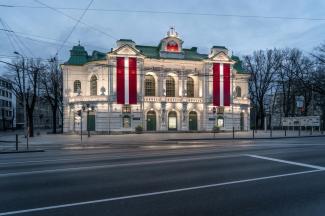
Opera, ballet and classical music
The Latvian National Opera and Ballet building is home to both the Latvian National Opera and the Latvian National Ballet. During the season, which runs from September to the end of May, an average of six new performances are staged. In total, more than 200 performances are shown during one season, and several orchestral and chamber music concerts are performed. The origins of opera traditions in Latvia can be traced back to the 18th century, when the first musical performances took place in the Duchy of Courland and the first travelling opera troupes appeared in Riga. In 1782, the City German Theatre building was opened, where both dramatic theatre, opera and ballet performances take place. The famous German composer Richard Wagner also worked there for a few years. The pleasure of magnificent classical music can be experienced at concerts by the world-renowned Latvian National Symphony Orchestra in a historic, atmospheric venue – the Great Guild Hall.
Cinematography
If you want to delve into the nuances of filmmaking, head to the Riga Film Museum, where small-scale exhibitions, lectures dedicated to cinema, events and film screenings are regularly held. Visitors are offered group tours, classes and creative workshops, designed for both film connoisseurs and those who are just starting to get to know cinema. The Splendid Palace cinema is one of the most magnificent and oldest European cinemas, which has been delighting film lovers with excellent and high-quality cinema since 1923. The cinema programme consists of high-quality auteur cinema, art house films from Europe and other regions of the world, as well as works that have been recognised at world film festivals. In addition, the cinema building itself has an impressive neo-baroque facade, but the interior surprises with the diversity of the neo-rococo style. For a different cinema experience, you can visit “Kino Bize”, a cosy cinema in the centre of Riga, created by friends, featuring the latest auteur cinema from around the world, as well as thematically designed retrospectives, lectures and special events. True film connoisseurs will appreciate the Riga International Film Festival, which takes place every autumn in the centre of Riga. It is an annual film festival that introduces the international film industry to current auteur works from the Baltic Sea region and the Nordic countries, and domestic film audiences to current world events.
